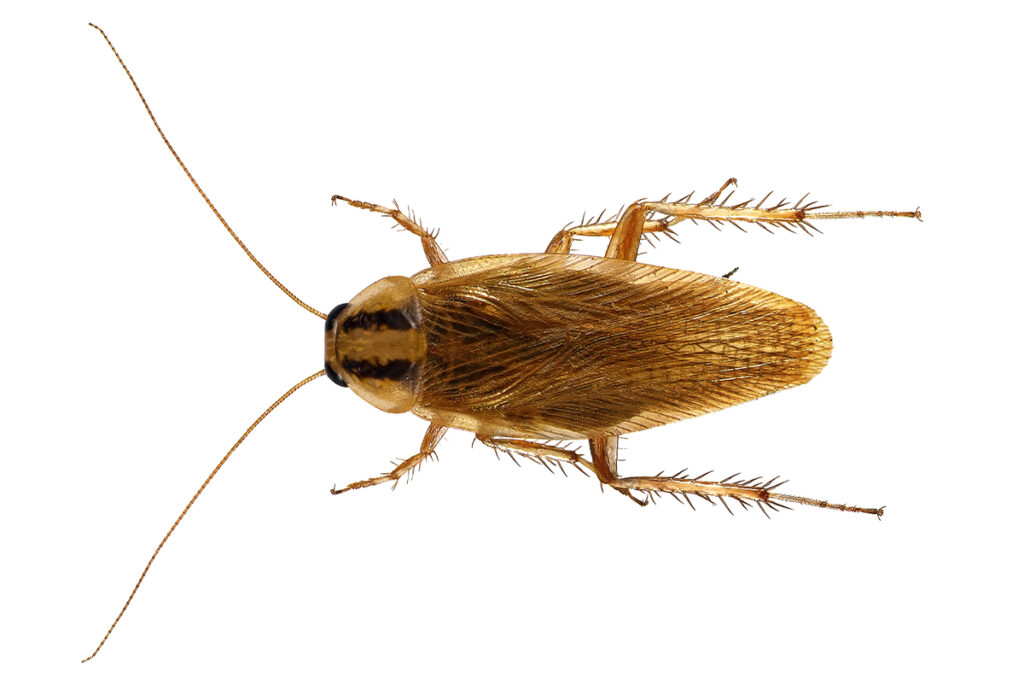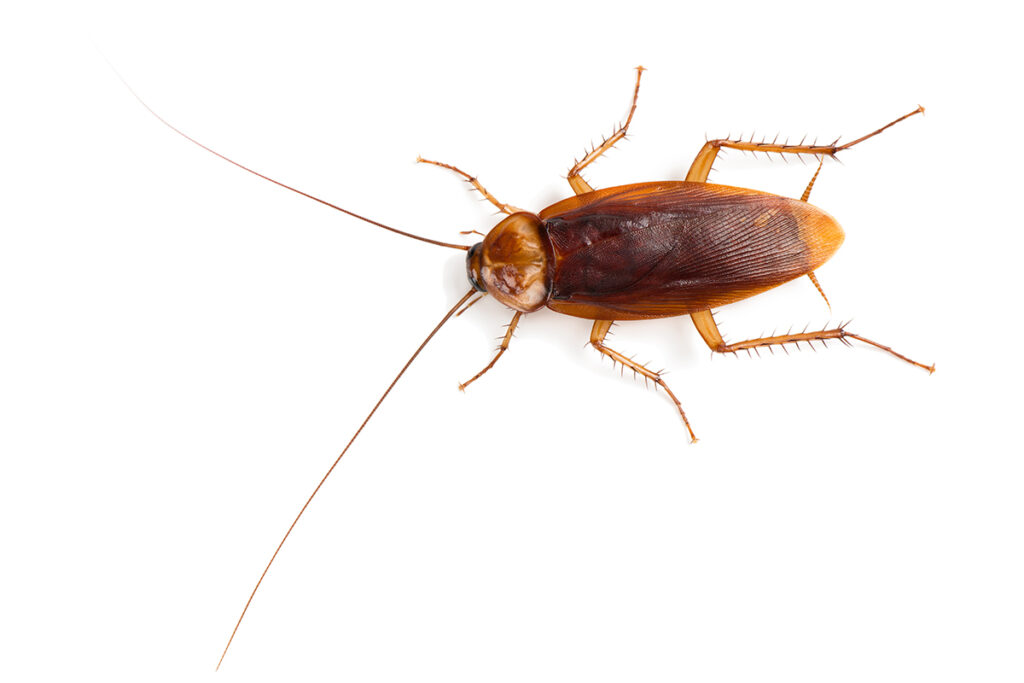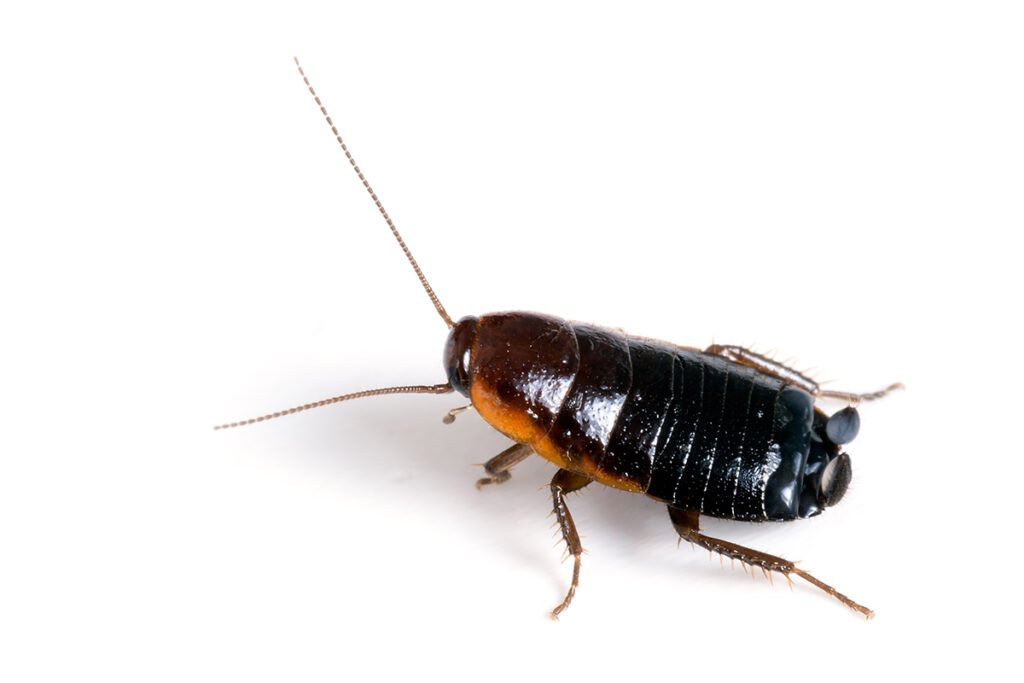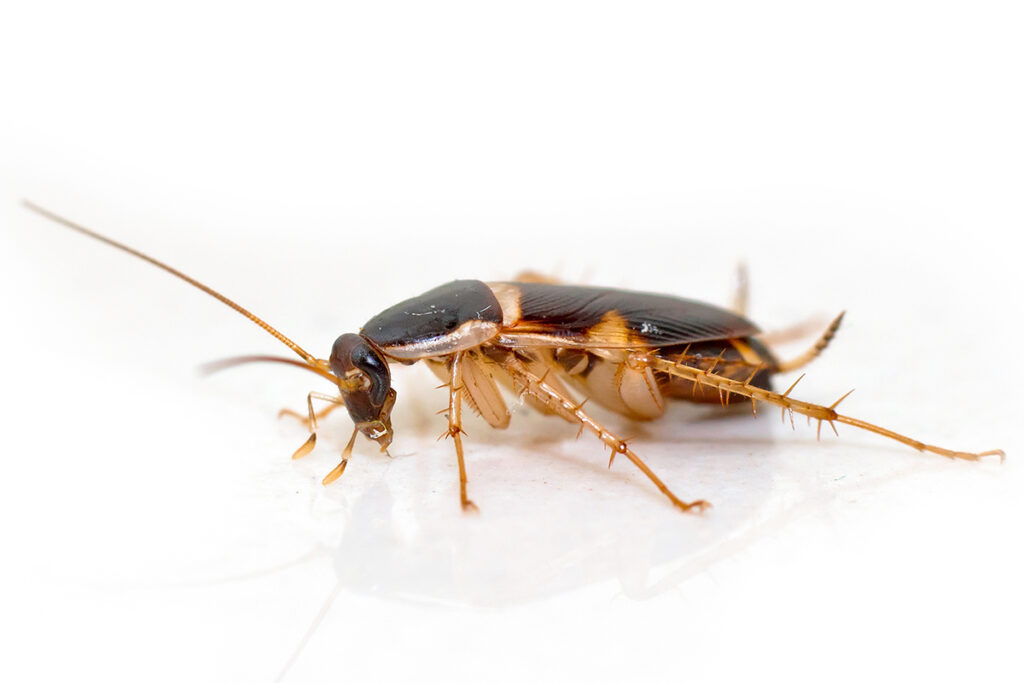German Cockroaches
The most common cockroach in the bay area... and the world!
The German cockroach is a small species of cockroach, typically about 1.6 cm to 1.7 cm long. It is light brown to dark brown in color and has two dark stripes on its back. It’s a tropical species that likely originated in Southeast Asia and thought to have spread around the world in ships’ cargo.
German cockroaches are the most common household roach pest. They are usually found in kitchens and bathrooms, but can be in any portion of a heated structure, especially near food preparation areas. A nocturnal insect, German cockroaches remain hidden in dark secluded harborages during the daylight hours. If you see some during the day, it is a sure sign that a tremendous population exists.
The most common signs of a German cockroach infestation are the presence of cockroaches themselves, as well as their droppings. Cockroaches are most active at night, so you may hear them scurrying around your kitchen or bathroom. You may also see cockroaches during the day if there is a large infestation. Cockroach droppings are small, dark, and cylindrical. They are often found near cockroach hiding places, such as in cracks and crevices.
Cockroaches are scavengers with a wide choice of food. They thrive on the same food humans eat and pollute human food in process of feeding. Cockroaches carry disease organisms on the loins and bristles on its body, as well as the sticky pads on its feet. Roaches defecate on food and transmit staphylococcus, streptococcus and E. Coli.
Unlike most other roaches, they are very small-with a body length of only ½ inch. They are a light brown or tan color, with the female being darker than the male.
The German cockroach female produces 4-8 egg capsules in her lifetime. Each capsule contains about 30-40 eggs. She carries the capsule until just before the eggs are ready to hatch. This usually takes 28-30 days. Nymphs go through 6-7 instars before becoming adults. The German cockroach population can grow at least 3-4 generations each year, and can complete the life cycle in as little as six weeks, but the average is 14-15 weeks. Adults will live up to ten months.
Pest Control For German Cockroaches
When dealing with a German cockroach pest control problem, it’s important to understand the level of infestation that you are facing. German cockroaches live in groups and multiply very quickly. In ideal conditions, they can produce three or four generations in one year.
If you’re dealing with a German cockroach pest control problem at home, then you may be wondering how so many roaches got into your house but the truth is that they have likely been living in your home for years.
You may have recently discovered that you have a serious cockroach infestation. Or, maybe you’ve been living with them for years but just haven’t realized how bad they can be until now. Cockroaches are notorious for being hard to get rid of and even harder to prevent from coming back.
If you want to solve your cockroach problem once and for all, then we recommend contacting us today! The first step is to schedule an appointment so one of our professionals can inspect your home in person and determine the best course of action based on the severity of your situation.
They are highly adaptable and can live for two months without food and one month without water.
The German cockroach is also a very adaptable species. It can survive without food for two months and without water for one month, which makes it highly resistant to starvation conditions. This cockroach can be found in any part of the house, including kitchens, bathrooms and bedrooms.
The German roach is usually much larger than other species of roaches that you may find around your home or property; they are about 1/2 - 3/4 inch long. They have two light-colored stripes behind their heads which give them their name: cockroaches look like small versions of male chickens.
The female German cockroach carries her egg capsule until the eggs are ready to hatch.
If you see a female German cockroach in your home, it is likely that she is carrying an egg capsule. The female carries the egg capsule for about two weeks until the eggs are ready to hatch. The egg capsule is about the size of a grain of rice and has a white oval shape with 25 eggs inside. This type of pest control problem can become very serious, especially if there are several females in one area that are pregnant at once.
For German cockroach control, there are several methods that can be used to get rid of these pesky pests. The use of baits is one method and involves placing them in areas where the German cockroach is most likely to find them. The bait needs to be placed where it will not be affected by other chemicals or cleaners you may have around your home, so keeping a clean environment is extremely important when using this method.
Another way to control the German cockroach population is through the use of insecticides such as boric acid dusts or sprays which contain pyrethroid products. Pyrethroids are non-repellent insecticides that kill insects by attacking their nervous system causing paralysis and death within hours after exposure
- Adults are very small and fast moving, making them difficult to control.
- Adults are very small and fast moving, making them difficult to control.
- They can fit through tiny cracks in the walls and other crevices.
- They are hard to spot, as they are nocturnal and tend to hide during the day.
Expert Pest Control Services
Getting rid of a German cockroach infestation requires professional intervention.
Getting rid of a German cockroach infestation requires professional intervention. You can’t just toss out some traps and hope for the best, because these pests are known to be immune to certain insecticides. If you want your home free from German cockroaches, call in the professionals!
With over 30 years’ experience in treating German cockroaches and other pests, Killroy Pest Control knows what it takes to get rid of these nasty bugs once and for all.
We can treat all areas where roaches could be hiding so they have nowhere left to hide come next springtime—and we’ll give you tips on how not only keep roaches out but also keep them from returning!
- This includes sealing up holes around doors or windows with silicone sealant
- Putting down glue boards near entry points as well as under sinks or behind furniture that may have been missed during previous treatments
- Placing sticky traps behind appliances such as refrigerators and microwaves (these areas tend not be treated by other companies)
- Vacuuming floors thoroughly after each treatment cycle ends
- Washing dishes by hand instead of putting them in dishwashers (as this allows any leftover food particles on plates/bowls/utensils etc., which could attract roach activity)
- Disposing trash regularly
There are several things to consider when hiring a company to get rid of cockroaches in your establishment including:
You may never see all of the roaches that are present in your home or business but professional pest control services will ensure that you no longer have an infestation.
- The number and species of roach present
- The size of your establishment, both square footage and building structure
- The kind of food being served at the establishment (if any)
If you’re currently dealing with a German cockroach infestation or want to prevent one from occurring, it’s best to contact a professional pest control company. A professional will inspect your home and determine the best methods for controlling the problem. If left alone, German cockroaches will continue to reproduce and their population will grow exponentially making them a serious health hazard for everyone and their pets.
In ideal conditions, the German cockroach breeds every six weeks.
You may have already heard that the German cockroach can breed every six weeks. This is an average number of eggs that a female lays to produce a new generation of cockroaches. However, this figure varies depending on the conditions in your home or workplace. For example, if there are plenty of food sources available and temperatures around 70 degrees Fahrenheit (21 degrees Celsius), it’s possible for a single female to lay more than 100 egg capsules in her lifetime — which means you could end up with hundreds upon hundreds of roaches!
The German cockroach produces the most offspring compared to other species of cockroach.
They leave their fecal deposits everywhere they travel, including food preparation surfaces and dishes.
While insecticides may kill some roaches, they don't eliminate all of the roaches or their egg capsules.
A sticky trap can help to identify problem areas in your home or business.
Types of Cockroaches in the Bay Area
The German Cockroach is the most common type of cockroach. They are small, brown, and have two dark stripes on their back.
The Brown-banded Cockroach is a distant fourth as they are very uncommon in our climate. They are small, brown, and have two dark bands on their back.




